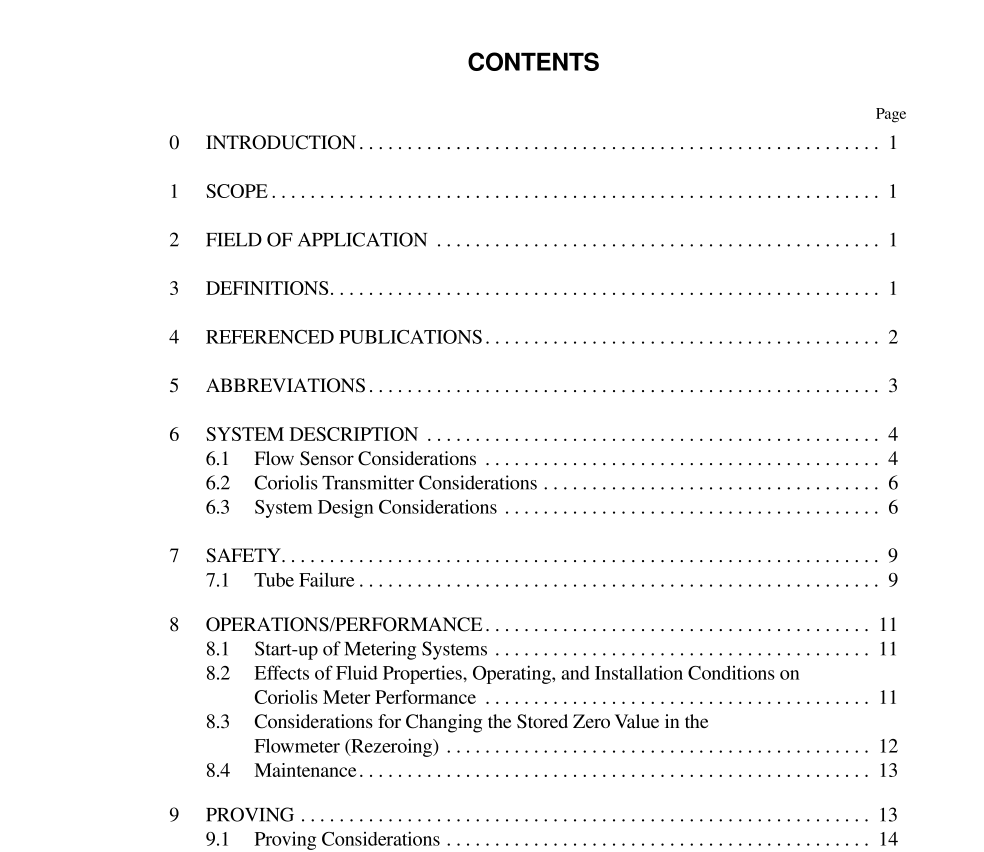API MPMS 5.6 pdf download

API MPMS 5.6 pdf download.Section 6—Measurement of Liquid Hydrocarbons by Coriolis Meters
3 Definitions
3.1 accessory equipment: Any additional electronic or mechanical computing, display, or totalization equipment used as part of the metering system. 3.2 base conditions: Defined pressure and temperature conditions used in the custody transfer measurement of fluid volume and other calculations. Base conditions may be defined by regulation or contract. In some cases, base condi- tions are equal to standard conditions, which within the U.S. are usually 14.696 psia and 60°F, and in other regions 101.325 kPa (absolute) and 15°C. 3.3 base density: The density of the fluid at base condi- tions. 3.4 calibration: The process of utilizing a reference standard to determine a coefficient which adjusts the output of the Coriolis transmitter to bring it to a value which is within the specified accuracy tolerance of the meter over a specified flow range. This process is normally conducted by the manufacturer. 3.5 cavitation: Phenomenon related to and following flashing if the pressure recovers and the vapor bubbles col- lapse (implode). Cavitation will cause a measurement error and can damage the sensor. 3.6 Coriolis meter: Also referred to as Coriolis mass meter or Coriolis force flowmeter. A Coriolis meter is a device which by means of the interaction between a flowing fluid and the oscillation of a tube(s), measures mass flow rate and density. The Coriolis meter consists of a sensor and a transmitter. 3.7 Coriolis meter factor, mass or volume ( MF , MF m , MF v ): A dimensionless number obtained by dividing the actual quantity of fluid passed through the meter (as deter- mined by proving), by the quantity registered by the meter. For subsequent metering operations, the actual quantity is determined by multiplying the indicated quantity by the meter factor. 3.8 Coriolis transmitter: The electronics associated with a Coriolis meter which interprets the phase shift signal from the sensor, converts it to a meaningful mass flow rate 3.17 primary element: See flow sensor. 3.18 proving: The process of comparing the indicated quantity which passes through a meter under test, at operating conditions, to a reference of known quantity in order to estab- lish a meter factor. This process is normally conducted in the field. 3.19 Pulse Scaling Factor: Abbreviated PSF , pulses per unit mass or volume; a coefficient entered in the Coriolis meter transmitter by the manufacturer or a user which defines the relationship between a pulse output and a quantity. A sim- ilar K-factor entered into the accessory equipment is used to translate the pulses back into a quantity. The PSF may be entered directly or derived from operator entries such as flow rate and frequency. 3.20 zeroing: A procedure that eliminates observed zero offset. The stored zero value is used by the Coriolis transmit- ter to calculate flow rate. Note: The zeroing operation should not be confused with resetting the totalizer. 3.21 zero offset, observed: The difference between the observed zero value and the stored zero value. 3.22 zero stability: The deviation from a zero indication by the meter over an appreciable time when no physical flow is occurring and no output inhibiting is applied. Note: This is a systematic uncertainty, which can be present over the working range of the meter. 3.23 zero value, observed: A measurement output indi- cating the average mass flow rate under zero flow conditions with no output inhibiting (i.e., no low flow cutoff and bi- directional flow) applied. 3.24 zero value, offset limit: The maximum allowable observed zero offset in relation to the stored zero value used to determine when to rezero the flowmeter; generally estab- lished by the user. 3.25 zero value, stored: The correction value stored in the transmitter which cancels out the flow rate observed at no flow conditions during zeroing of the flowmeter.









